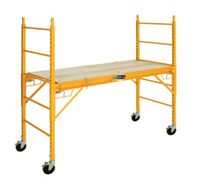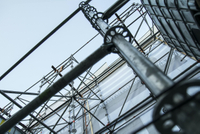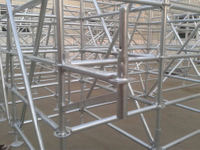Content Menu
● What Is Ringlock Scaffolding?
● Key Components of Ringlock Scaffolding
● Why Use Ringlock Scaffolding for High-Rise Projects?
● Assembly Process and Best Practices
● Safety Considerations in High-Rise Ringlock Scaffolding
● Load Capacity and Structural Integrity
● Cost Factors in High-Rise Applications
● Conclusion
● FAQ
>> 1. What makes ringlock scaffolding better suited for high-rise buildings compared to traditional scaffolding?
>> 2. How high can ringlock scaffolding safely be constructed?
>> 3. Are there specific safety features integrated into ringlock scaffolding for high-rise projects?
>> 4. Can ringlock scaffolding be customized for complex high-rise building shapes?
>> 5. How does the cost of ringlock scaffolding compare to other scaffolding systems on high-rises?
Ringlock scaffolding is widely recognized as one of the safest, most versatile, and efficient scaffolding systems available in the construction industry today. For high-rise projects, where safety, load capacity, and speed are paramount, ringlock scaffolding has become the go-to modular solution. This comprehensive guide discusses everything you need to know about using ringlock scaffolding in high-rise construction—from its components and features to assembly guidelines, safety standards, and cost considerations.

What Is Ringlock Scaffolding?
Ringlock scaffolding is a modular scaffolding system known for its rosette or ring-shaped connection points welded on vertical posts (standards). Each rosette can connect up to eight components, including horizontal ledgers and diagonal braces, enabling complex and stable configurations ideal for high-rise structures.
This system allows easy assembly and disassembly with wedge-head connections locking components securely without the need for bolts or nuts, drastically reducing installation time compared to traditional tube and clamp scaffolding.
Ringlock scaffolding is widely used in:
- High-rise building construction
- Bridge and infrastructure projects
- Industrial plants and petrochemical facilities
- Large-scale event staging
The robust design and standardized components make ringlock scaffolding especially suitable for multi-story construction where speed, safety, and structural integrity are critical.
Key Components of Ringlock Scaffolding
Component | Description |
Vertical Standards | Primary vertical load-bearing posts with welded rosettes spaced typically every 0.5 meters. |
Horizontal Ledgers | Connect standards horizontally, supporting platforms and contributing to lateral stability. |
Diagonal Braces | Connect diagonally to resist lateral forces and minimize swaying in tall structures. |
Rosette Connectors | Welded ring nodes allowing versatile multi-directional connections for complex scaffolds. |
Base Jacks | Adjustable base plates for setting the scaffold level on uneven ground. |
Steel Planks | Galvanized, anti-slip walkway boards for safe worker movement and material handling. |
Toe Boards | Edge protections installed along platforms to prevent tools or debris from falling. |
Guardrails & Stair Towers | Critical safety features for access and fall prevention across levels. |
Why Use Ringlock Scaffolding for High-Rise Projects?
High-rise construction demands exceptional safety, flexibility, and load-bearing performance. Ringlock scaffolding excels by:
- Rapid Assembly and Dismantling: Wedge-head connections enable fast, tool-free installation, essential for time-sensitive skyscraper builds.
- Superior Load Capacity: Standards and braces support heavy material and worker loads per EN 12810 and EN 12811 standards.
- 360° Multi-Directional Access: Rosette nodes allow connections at multiple angles, facilitating scaffolds around irregular façades and corners.
- Height Stability: Diagonal bracing and robust base jacks provide resistance to wind loads and structural sway common in tall buildings.
- Integrated Safety Features: Guardrails, stair towers, and toe boards are often pre-engineered into systems to comply with international safety codes.
- Adaptability: Easily configured for façade scaffolding, suspended scaffolds, cantilever projects, or overhead protection.
This makes ringlock scaffolding indispensable for the architecture and engineering challenges of towering construction projects.
Assembly Process and Best Practices
High-rise ringlock scaffolding assembly demands precision and adherence to protocol:
1. Site Preparation: Ensure level ground; install base plates or sole boards on stable surfaces.
2. Position Vertical Standards: Insert standards with welded rosettes at intervals aligned with planned deck heights (0.5m increments).
3. Attach Ledgers Horizontally: Secure horizontal ledgers via wedge heads into rosettes to outline platform frames.
4. Install Diagonal Braces: For stiffness and wind resistance, diagonal braces are fitted at prescribed intervals.
5. Lay Steel Planks: Position steel planks with secure hooks across frames, creating walkways and working platforms.
6. Add Safety Components: Toe boards, guardrails, and stairways are installed as per regulations.
7. Inspection and Testing: Conduct thorough stability checks and load testing before allowing work.
Each stage demands thorough training and qualified personnel to ensure compliance with safety guidelines. Frequent inspections during construction minimize risks.
Safety Considerations in High-Rise Ringlock Scaffolding
Safety is paramount in high-rise scaffolding:
- Competent Personnel: Only qualified supervisors and trained riggers should erect, modify, or dismantle the scaffold.
- Load Limits: Never exceed the manufacturer's rated loads for personnel, tools, and materials.
- Fall Protection: Use integrated guardrails and personal fall arrest systems as mandated by OSHA and local codes.
- Regular Inspections: Daily visual checks and documented periodic inspections identify hazards early.
- Secure Connections: Tight wedge fittings ensure connections resist dynamic and lateral forces.
- Access Control: Mark scaffold zones clearly and control unauthorized access according to safety protocols.
Following these measures minimizes accidents and supports safe high-rise scaffold use.

Load Capacity and Structural Integrity
Ringlock scaffolding components are rigorously engineered to carry substantial loads:
Element | Typical Load Capacity |
Vertical Standards | Up to 15 kN per standard depending on grade |
Horizontal Ledgers | 5–10 kN depending on length and material |
Diagonal Braces | Designed to resist lateral forces and sway |
Platforms (Steel Planks) | Uniform load capacities typically exceed 200 kg/m² |
Load capacities vary per project specifications and should adhere to EN 12810/12811 and all local building codes.
Structural integrity is enhanced through:
- Proper bracing patterns
- Rigorous component quality control
- Engineering design approval for heights exceeding 30 meters
- Use of hot-dipped galvanized steel for corrosion resistance
Cost Factors in High-Rise Applications
Several factors influence the overall cost of ringlock scaffolding in tall projects:
Cost Factor | Impact Explanation |
Material Quality | Higher-grade steel and galvanizing increase upfront costs but reduce maintenance expenses. |
Height and Volume | Taller, larger scaffolds require more standards, ledgers, and accessories. |
Labor Efficiency | Fast assembly reduces labor time and costs compared to traditional scaffolding. |
Project Duration | Rental vs. purchase decisions impact cash flow and total scaffold expenses. |
Compliance and Safety | Investment in safety systems and inspections may raise costs but avoid costly accidents. |
Transportation and Access | Urban or constrained sites may incur additional logistics costs. |
Planning early with suppliers and contractors is critical to balancing budget and safety requirements.
Conclusion
Ringlock scaffolding stands out as an ideal system for high-rise construction projects due to its modular design, rapid assembly, high load capacity, and exceptional safety features. Its ability to adapt to complex geometries and provide 360° connection flexibility makes it indispensable for skyscrapers and tall infrastructure works. While upfront costs can be higher than traditional systems, the benefits in safety, speed, durability, and compliance significantly outweigh the expenses for large-scale vertical projects.
Careful planning, certified components, and qualified erection teams are crucial to harnessing the full advantages of ringlock scaffolding for high-rise buildings. By adhering to safety protocols and leveraging ringlock's innovative design, contractors can deliver projects efficiently while prioritizing worker safety at great heights.

FAQ
1. What makes ringlock scaffolding better suited for high-rise buildings compared to traditional scaffolding?
Ringlock scaffolding's unique rosette connection system allows multi-directional, secure, and fast assembly while maintaining high load-bearing capacity and stability under wind loads on tall structures, unlike tube-and-clamp systems that require more labor and are prone to errors.
2. How high can ringlock scaffolding safely be constructed?
With proper engineering and compliance with safety standards, ringlock scaffolding can be safely erected well beyond 30 meters (approximately 100 feet). Taller systems require professional structural design and regular inspections.
3. Are there specific safety features integrated into ringlock scaffolding for high-rise projects?
Yes, ringlock scaffolding incorporates built-in guardrails, toe boards, stair towers for safe access, and wedge-head locking mechanisms that prevent accidental disengagement, aligning with OSHA and EN regulations for worker safety.
4. Can ringlock scaffolding be customized for complex high-rise building shapes?
Absolutely. The rosette nodes allow up to eight connections at various angles, making ringlock scaffolding extremely adaptable to curved façades, corners, window recesses, and other architectural complexities.
5. How does the cost of ringlock scaffolding compare to other scaffolding systems on high-rises?
While the initial investment in ringlock scaffolding can be higher than basic scaffold types, savings on labor, enhanced safety reducing downtime, and lower maintenance costs typically make it more cost-effective on large high-rise projects overall.






















